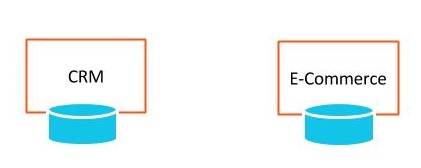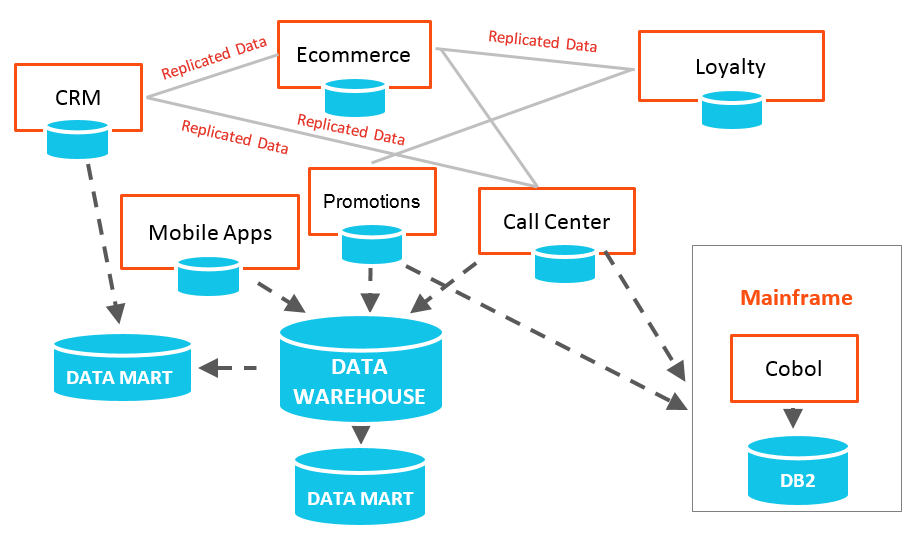Today we hear a lot about digital transformation and companies that are evolving at a technically insufficient rate compared to what their business demands. This situation, usually linked to technological decisions of the past, conditions the company's ability to explore new avenues, to tackle new challenges and, finally, to differentiate itself in a market that is as difficult and changing as we see today.
One of the most recurrent problems, and one that generates the greatest inefficiency, is the lack of organisation around the data stored and the consequent issues with exploitation that these give rise to.
Many organisations are taking the initiative by completely remodelling their architecture from the ground up, putting data first and recovering the lost ground.

Let's start at the beginning. The way in which this situation has been reached, as I mentioned before, is due to technological decisions taken in the past, guided by the rigid, original methodologies of the time, and that implied the construction of different applications with each solving a very specific problem, thereby creating enormous silos.

Following this architecture and its principles, if we were now to want to create a function requiring information from the two silos represented, we would have to create complex systems for interconnecting between applications or, even worse, for synchronising databases to feed information into this new feature.
Extending the number of applications to incorporate in the architecture, we would find a scenario like the one shown in the following schema:

This is not a new situation for anybody—it is the reality for many companies. However, we are going to be hindered by many tasks:
- Avoiding duplicating data. Every application has its own BBDD and is responsible for it, so we will get duplicates or data synchronisation problems if we want to link them.
- Including Real-Time operations in data analysis and processing.
- Scaling horizontally as our product requires in a global way.
- Optimising the costs of infrastructure and development.
- Eliminating information silos so that data flows between applications synergies can be exploited.
- Keeping the Total Cost of Ownership ratio low (TCO).
With such an application-centric approach, it's hard to focus on what's really important: clients and their interaction with the service we offer.
Leaving aside the technical complexity, the meagre possibilities to offer relevant information in real time, the difficulty of maintaining the architecture and, thereby, the expense of this solution, we must consider if this is the way in which we want our business to evolve.
Making our business evolve is no easy task, so we must equip ourselves with the best tools in each case. Taking advantage of the approach that follows Scrum or other Agile methodology, through empiricism, short iterations and through delivering continuous and incremental value, will allow us to improve the interpretation of our clients’ true needs.
We think that we must promote and push companies’ digital transformation following an approach that is diametrically opposite in form and substance. We emphasise precisely the clients that will connect with our business and how they interact with it. This is what we call Customer Centric*.*
We want to know our client better and be prepared to respond immediately to their present and future needs. It is therefore indispensable, in the connected society in which we live, to give the customer the ability to have ubiquitous access to products and services at all times, Digital Channels.
Not only must we keep the data in an organised fashion, we also complete this vision with the ability to analyse and process in real time all the data obtained, to become a company driven by data that improves decision-making by applying intelligence to them, Data Intelligence*.*
These three key concepts revolve around the data we have and the use we will make of them. Data Centric is our approach and stands as a backbone to which to guide us in the digital transformation of our clients.
Like a planet, with the Data Centric architecture we constructed a system of layers that allows homogenisation, the use of resources and the synergy that will facilitate the creation of intelligent and rich applications with a unique view of the data, that is, the client.
Data
At the centre of the architecture is the data. We will combine storage in caches, documents, semantic or transactional searches, etc. We must use the best possible data storage for each specific use case. This concept is known as Multi-Datastore. It is possible because the DaaS layer abstracts access to these information containers.
Intelligence
On the data there is a layer that will apply intelligence to it, enriching it and changing it from raw data to smart data. In this layer we will be able to carry out machine learning or artificial intelligence operations to provide the maximum possible intelligence to the data and make it available for business in real time.
DaaS or Data as a Service
This is the only access point to the data. It will centralise interaction with the model, making the logical model independent from the physical one. It allows us to separate the operation of the storage engines’ business applications thanks to the maintenance of this layer that functions as a proxy between the two worlds. In this way, if we wanted to change a storage technology or include a new one, we could do this by maintaining the interface with the business layer.
Business
This will be all the services that provide the functions necessary for the business. This layer will be the one that we expose via API, ideally through some API Manager to be reused by all the appropriate applications, no matter whether they internal or third-party. Reusing this service layer between applications will allow us to reduce the lines of code deployed and maintain a uniform view of the information.
Applications
Web, mobile, company CRM, etc... are some examples of end-to-end applications that interact with the Data Centric]] architecture from the last layer and which take advantage of the entire range of services made available to them. In this scenario it is easy to grow the ecosystem of applications making use of resources already available.
As will be seen from the architecture explained above, thanks Data Centric we are able to:
- Centralise data in such a way as to avoid duplication and inconsistencies of information between applications and departments. A unique view of the data.
- Get rid of organisation silos by integrating business units into the global vision.
- Make informational and operational systems coexist in the same architecture in a synchronised way.
- Analyse, transform and integrate data immediately by connecting directly to applications offering intelligence in Real Time.
- Modernity thanks to disruptive technologies in all areas. It uses microservices guaranteeing flexibility, development independence and unlimited horizontal scalability.
- Reducing the Time to Market thanks to component reuse and knowledge sharing.
There are many benefits of Data Centric architecture. In this post, I have given a brief sketch of the vast potential that it has. I am not saying at all that it is easy, but the question that you must ask is if your company is prepared to face the challenge of transforming and turning towards a model in which data, and the information that we infer from it, really takes centre stage.
Following the Agile route, applying ambitious cultural and technological changes is what will give your organisation people who are motivated, technologically restless and eager to test and discover new limits, which will result in the flexibility to adapt to the market changes, to look for new business opportunities and, in short, to give more value to the society in which we live.
It is everyone's responsibility to build a better society, but rest assured that you are not alone in this.
Comments are moderated and will only be visible if they add to the discussion in a constructive way. If you disagree with a point, please, be polite.




Tell us what you think.